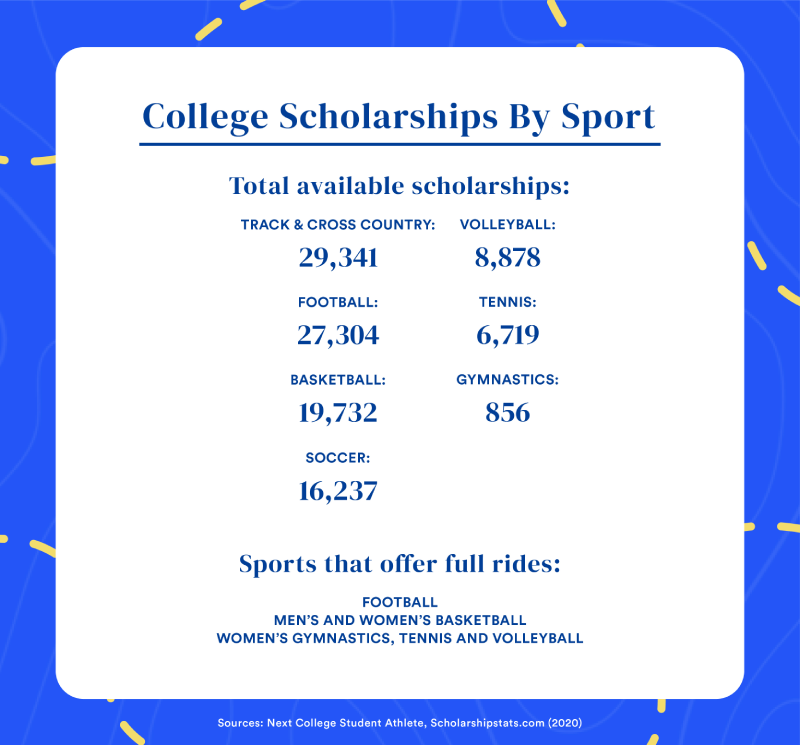Top banks for student athletes in 2022

The Bankrate promise
At Bankrate we strive to help you make smarter financial decisions. While we adhere to strict , this post may contain references to products from our partners. Here's an explanation for .
Everyone knows that a person’s college years tend to be expensive ones, as the costs of factors such as tuition, housing and meals really add up — not to mention many of these prices are soaring due to decades-high inflation. Students who participate in college athletics programs may find it particularly difficult to pay for out-of-pocket costs, since they often cannot work a job due to the time commitment of classes and sports.
Some ways student athletes can offset the high price of their college years include sports-related scholarships and grants — and some student athletes even earn money now through paid endorsements.
Smart money management for college athletes involves knowing what financial perks are available to offset college costs, as well as using a bank that best meets one’s financial needs. (Compare savings accounts to find the best rates.)
Key scholarship statistics:
The National Collegiate Athletic Association (NCAA) administers intercollegiate athletics across three divisions and 24 sports, with Division I being the highest of the three. Schools with this top classification account for nearly two-thirds of the athletic scholarship money awarded, according to Scholarshipstats.com, which reported average amounts for 2019-2020 athletic scholarships.
- Division I: $18,013 for males and $18,722 for females
- Division II: $6,588 for males and $8,054 for females
Athletic scholarships are not given to those who play Division III-level sports.

While an athletic scholarship can cover all expenses related to college, it often covers just a portion of it, and the amount awarded to an athlete can vary based on the pool of money the coach is given to distribute. What’s more, athletic scholarships are commonly offered one year at a time, and can be renewed by the coach or athletic department for another year if the athlete remains eligible — so there’s no guarantee an athlete will receive the scholarship throughout their entire college career.

After scholarships and grants, many student athletes still have multiple out-of-pocket expenses to cover each year. They may need to pay for at least part of their room and board, tuition, books, transportation and daily living costs. The average cost of college expenses, before any scholarships or grants are factored in, includes:
ExpenseAverage annual cost at public 4-year school
| In-state tuition | $9,349 |
| On-campus room and board (including meals) | $11,303 |
| Books and supplies | $1,291 |
Top 5 banks for student athletes
Finding a bank that best suits an individual’s needs is important for anyone in managing their finances. College students may commonly seek a bank that offers options such as fee-free checking accounts and a robust mobile app. Those who are athletes may travel often and therefore may find it especially important to have access to a large ATM network.
The five best banks for college students, including those who are athletes, are:
- Chase Bank: Chase offers a college student checking account that does not charge a monthly fee, and the bank’s robust network of 16,000 ATMs nationwide can be a plus for athletes who travel frequently for sporting events. It also maintains 4,700 branches for in-person customer support.
- PNC Bank: PNC’s student accounts charge no maintenance fees, and the bank reimburses some ATM fees each month, which can be convenient for athletes who travel. Students can also benefit from mobile app features including low-balance alerts and budgeting tools.
- Capital One: Capital One can be a convenient option for students looking for savings and checking accounts with competitive rates, as well as no minimum balance requirements, maintenance fees or overdraft fees. It operates branches in nine Eastern and Southern states, as well as around 50 Capital One Cafes. The highly rated mobile app allows you to set up an automated savings plan.
- Ally Bank: Ally offers accounts with competitive rates and no maintenance fees — including an interest-bearing checking account that requires no minimum balance. The bank provides two types of overdraft coverage, neither of which charges fees. Customers of this online-only bank have fee-free access to 43,000 Allpoint ATMs nationwide.
- Alliant Credit Union: While Alliant doesn’t offer student-specific products, its checking and savings accounts pay competitive rates and charge no maintenance fees. Customers have access to 80,000 fee-free ATMs, and Alliant reimburses up to $20 a month in ATM fees. It’s easy to become a member of this credit union, which is best suited for those who prefer online banking, since there are no branches.
Best checking & savings accounts for college athletes
Best college student-athlete accounts
| Checking | Savings |
|---|---|
| Chase College Checking: This account charges no monthly fees to students up to the age of 24, and provides access to 16,000 ATMs and 4,700 branches. | Ally Bank Online Savings: While it isn’t a student-specific account, Ally’s savings account pays a competitive yield and charges no maintenance fees. Students can benefit from Ally’s digital money management tools for budgeting and building up savings. |
| PNC Virtual Wallet Student: This package of two checking accounts and one savings account requires no minimum deposit for accounts opened online. Each month, two non-PNC ATM fees are reimbursed, as well as $5 in other ATMs’ surcharges. | Capital One 360 Performance Savings: In addition to paying a competitive yield, this account helps you save money through setting up savings goals as well as automatic transfers from a linked checking account. |
|
U.S. Bank Student Checking: This account comes with a free first checkbook and no maintenance fees, and you won’t be charged a fee if the account is overdrawn by $50 or less at the end of a day.
Students at participating colleges can also link a student ID to the checking account, and use the ID for ATM transactions and on-campus purchases — a perk for athletes and other busy students who don’t always carry their debit card. |
Alliant High-Rate Savings: Alliant’s savings account earns a high rate on balances of $100 or more, and you won’t pay monthly fees if you sign up for e-statements. Members can open up to 19 savings accounts, each devoted to a different goal. While there are no branches, Alliant offers a highly rated mobile app and 80,000 fee-free ATMs nationwide. |
| Bank of America Advantage SafeBalance: This account charges no monthly fee for students under age 25, and there are no overdraft fees. You can receive customized account alerts via the mobile app, texts or email. | Chime High Yield Savings Account: Financial technology company Chime’s savings account earns a competitive yield, and it requires no minimum balance. While a checking account is required to be eligible for the savings account, the two can work together to help you reach your savings goals: Debit card purchases can be rounded up to the nearest dollar, with the difference transferred to your savings account. You can also deposit a portion of your paycheck automatically to the savings account with each direct deposit. |
NIL deals, sponsorships and endorsements
Many college athletes need to foot the bill for at least some of their college expenses, yet recent changes in the law have also afforded new opportunities for these athletes to earn money as well.
As of June 2021, student athletes are able to make money off their name, image and likeness (NIL), thanks to new state laws and changes in NCAA policy. This can be done through corporate sponsorships or the athlete selling products or services directly.
Doug Edert
Basketball guard Doug Edert signed an NIL deal with Buffalo Wild Wings in 2022 for which he promoted the restaurant’s offer of free boneless chicken wings if an NCAA March Madness tournament game went into overtime. At the time, Edert played for the St. Peter’s Peacocks and had helped the team reach the Sweet 16 of the 2022 men’s NCAA tournament.
Rayquan Smith
Rising senior Rayquan Smith, a Norfolk State University football and track athlete, has been involved in various NIL deals and currently has nearly 100,000 followers on TikTok. Dubbed on Twitter as the “King of NIL,” Smith has promoted companies and products on social media such as Arby’s, Eastbay, Boost Mobile, Spikeball and the Iron Chest Master.
Haley and Hanna Cavinder
On July 1, 2021 — the first day the new NIL rule took effect — twins and then-Fresno State Bulldogs basketball guards Haley and Hanna Cavinder announced endorsement deals with companies Boost Mobile and Six Star Pro Nutrition. Their combined sponsorship income is $1 million, according to a Time estimate.
Opportunities for lower NCAA divisions
While Division I players have typically landed the larger NIL deals, Division II and III players can also capitalize on their name, image and likeness to help offset college expenses or build up a savings account. Some such lower-level athletes have earned money for doing sponsored social media posts, hosting sports clinics or signing autographs.
Student athletes looking for NIL opportunities have access to various platforms that can help match them with brand partnerships, licensed merchandise, podcasts and more. Examples include Athlete Direct, Athletepreneur and CoachTube. Some athletes also hire marketing agents to help them find and negotiate sponsorships.
Student athletes and the need for money management
Being financially literate can help college athletes who are juggling tuition and living expenses with saving for the future, as well as potentially earning money in endorsements.
Many former students continue to pay off their college years after they’ve joined the workforce. More than 1,500 of 2,000 students surveyed in January and February 2022 said they would have student loan debt after graduation, according to a poll conducted by Kaplan, in association with organizations Inside Higher Ed and College Pulse.
Students in this survey also reported having other types of debt, with 23 percent carrying a credit card balance and 14 percent owing money on a car loan. What’s more, 25 percent and 17 percent said they’ve experienced food and housing insecurity, respectively.
When asked how worried they felt that a significant expense, such as a large car repair bill, might cause them to drop out of college, 35 percent of the Kaplan survey respondents said they were very worried and 29 percent reported being somewhat worried.
Research suggests that while students who are nonathletes have greater financial knowledge than those who are athletes, those who are athletes have greater financial confidence than the nonathletes, according to a 2019 article published in “Sports, Business and Management: An International Journal.”
Student athletes and nonathletes alike may increase their financial literacy and confidence by enrolling in a college personal finance course, which can cover balancing a checkbook, avoiding credit card debt, paying off student loans and saving for future goals.
Finding the right bank account can also be key in helping college students manage their finances through things like direct deposit, online bill pay, ATM access, and the potential to earn interest on savings.
Bottom line
Playing a college sport can earn you an athletic scholarship and maybe even endorsement money, but most college athletes still need to foot the bill for at least some of their room and board, tuition and living expenses. For many of these athletes, a successful financial future involves learning healthy money management skills and finding the best checking and savings accounts for their needs.
Related Articles



